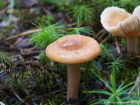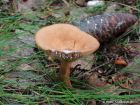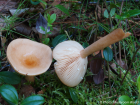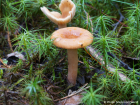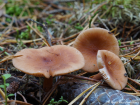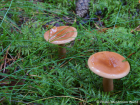Cap convex, sometimes with a central umbo, that flattens with age. It varies between orange-brown and a dull chestnut in colour, and the surface is dry and matt. The margin often has tiny lobes and can be crimped or crisped. Gills at first ochraceous-buff, becoming pale cinnamon with a pinkish tinge, adnate or slightly decurrent, narrow and fairly crowded. Stem colour ranges from reddish-brown to brick-coloured and is either roughly equal in width or slightly tapers towards the top. The stem flesh is whitish, and there is no presence of a stem ring. Spore print pale cream with a slight salmon pink tinge.
Microscopic Features: The spores are ellipsoidal in shape, measuring about 7-9 x 6-7μm. They have a transparent appearance and are adorned with numerous pointed warts, reaching a height of up to 1.2μm. These warts are mostly found as isolated structures, although there are a few connecting ridges present as well.
Lactarius tabidus on the www.first-nature.com web site.
Many mushrooms are poisonous, and some can be lethally toxic. Distinguishing between edible and poisonous mushrooms can be very challenging. Therefore, we strongly advise against consuming wild mushrooms. This website does not contain any information about the edibility or toxicity of mushrooms.
Although efforts have been made to ensure accuracy on this website, the information may contain errors and omissions. Therefore, all content provided is for educational and informational purposes only and should not be relied upon or used as a basis for consuming any plants or mushrooms.
External links are provided for reference only. We do not endorse or take responsibility for the content, advice, or products found on these sites or in any advertisements shown on this website.
